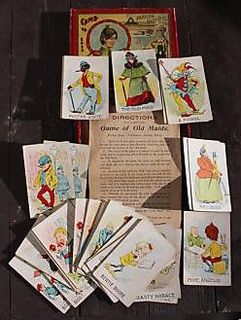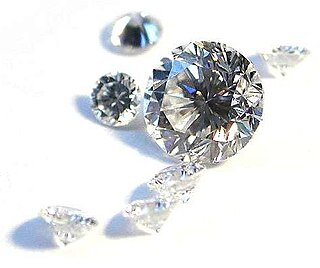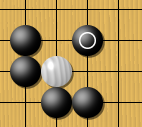
Go or Weiqi, Weichi is an abstract strategy board game for two players in which the aim is to surround more territory than the opponent. The game was invented in China more than 2,500 years ago and is believed to be the oldest board game continuously played to the present day. A 2016 survey by the International Go Federation's 75 member nations found that there are over 46 million people worldwide who know how to play Go and over 20 million current players, the majority of whom live in East Asia.

The rules of Go have seen some variation over time and from place to place. This article discusses those sets of rules broadly similar to the ones currently in use in East Asia. Even among these, there is a degree of variation.
A Japanese proverb may take the form of:

A torii is a traditional Japanese gate most commonly found at the entrance of or within a Shinto shrine, where it symbolically marks the transition from the mundane to the sacred.

Old maid is a Victorian card game for two or more players probably deriving from an ancient gambling game in which the loser pays for the drinks.

Life and death (死活) is a fundamental concept in the game of Go, where the status of a distinct group of stones is determined as either being "alive", where they may remain on the board indefinitely, or "dead," where the group will be lost as "captured". The basic idea can be summarized by:

In go and shōgi, a jōseki or jouseki is the studied sequences of moves for which the result is considered balanced for both black and white sides.

A diamond cut is a style or design guide used when shaping a diamond for polishing such as the brilliant cut. Cut does not refer to shape, but the symmetry, proportioning and polish of a diamond. The cut of a diamond greatly affects a diamond's brilliance; this means if it is cut poorly, it will be less luminous.

Sharpening stones, or whetstones, are used to sharpen the edges of steel tools and implements, such as knives, scissors, scythes, razors, chisels, hand scrapers, and plane blades, through grinding and honing.

Puffed rice and popped rice, are types of puffed grain made from rice commonly eaten in the traditional cuisines of Southeast Asia, East Asia, and South Asia. It has also been produced commercially in the West since 1904 and is popular in breakfast cereals and other snack foods.
The four arts, or the four arts of the Chinese scholar, were the four main academic and artistic talents required of the aristocratic ancient Chinese scholar-gentleman. They were the mastery of the qin, qi, shu and hua, and are also referred to by listing all four: 琴棋書畫; qínqíshūhuà.

Go equipment refers to the board, stones, and bowls for the stones required to play the game of Go. The quality and materials used in making Go equipment varies considerably, and the cost varies accordingly from economical to extremely expensive.

A Go opening refers to the initial moves of a game of Go. On the traditional 19×19 board the opening phase of the game usually lasts between 15 and 40 plies. There is some specialised terminology for go openings. The precise meanings of Japanese language terms is often misunderstood.

There are many variations of the simple rules of Go. Some are ancient digressions, while other are modern deviations. They are often side events at tournaments, for example, the U.S. Go Congress holds a "Crazy Go" event every year.

In the game of Go, shape describes the positional qualities of a group of stones. Descriptions of shapes in go revolve around how well a group creates or removes life and territory. Good shape can refer to the efficient use of stones in outlining territory, the strength of a group in a prospective fight, or making eye shapes so that a group may live. Bad shapes are inefficient in outlining territory and are heavy. Heavy groups cannot easily make eye shapes and are therefore good targets for attack. Understanding and recognizing the difference between good shape and bad is an essential step in becoming a stronger player.

Diamond is one of the best-known and most sought-after gemstones. They have been used as decorative items since ancient times.

Hiromi Itō is one of the most prominent women writers of contemporary Japan, with more than a dozen collections of poetry, several works of prose, numerous books of essays, and several major literary prizes to her name. She divides her time between the towns of Encinitas, California and Kumamoto in southern Japan. She is currently teaching at School of Culture, Media and Society in Waseda University, Tokyo.
Kenta Nishimura was a Japanese novelist. He was awarded the 2010 Akutagawa Prize for the novel Kueki Ressha (苦役列車). Having dropped out of school at fifteen, Nishimura's lack of formal education and candidness concerning his lifestyle has drawn media attention.

High School Prodigies Have It Easy Even in Another World , abbreviated as Chōyoyū (超余裕), is a Japanese light novel series written by Riku Misora and illustrated by Sacraneco. SB Creative published ten volumes between 2015 and 2020 under their GA Bunko imprint. A manga adaptation with art by Kōtarō Yamada was serialized in Square Enix's seinen manga magazine Young Gangan from May 2016 to October 2021. It has been collected in ten tankōbon volumes. Both the light novel and manga are licensed in North America by Yen Press. An anime television series adaptation by Project No.9 aired from October 3 to December 19, 2019.









